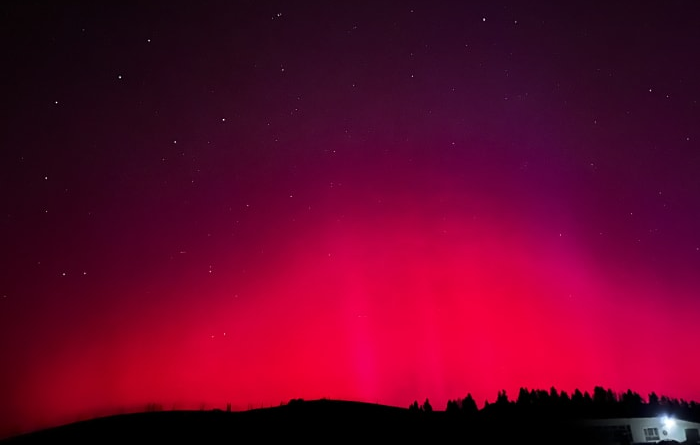Federal agency says a second, if weaker, solar storm surge is likely Sunday – KSAT San Antonio
Tom Krisher, Josh Funk And Marcia Dunn
Associated Press
Published:
Updated:
Tom Krisher, Josh Funk And Marcia Dunn
Associated Press
Xinhua
In this photo released by Xinhua News Agency, the Northern Lights, or Aurora Borealis, are seen near Nanshan scenic spot in Urumqi in northwestern China’s Xinjiang Uyghur Autonomous Region, Saturday, May 11, 2024. An unusually strong solar storm hitting Earth produced stunning displays of color in the skies across the Northern Hemisphere early Saturday, with no immediate reports of disruptions to power and communications. (Chen Shuo/Xinhua via AP)
A U.S. government agency said a weaker repeat of Saturday’s powerful solar storm was likely on Sunday.
The U.S. National Oceanic and Atmospheric Administration said that “coronal mass ejections” — clouds of ejected solar plasma that can cause power grid irregularities and issues with high-frequency communications and global positioning systems — will slam into the Earth’s magnetic field and outer atmosphere until at least Sunday night.
Recommended Videos
On Saturday, the powerful solar storm put on an amazing skyward light show across the globe overnight but caused only minor disruptions to the electric power grid, communications and satellite positioning systems.
The Federal Emergency Management Agency said that no FEMA region reported any significant impact from the storms. The U.S. Department of Energy said Saturday it was not aware of any impact from the storms on electric customers.
SpaceX’s Starlink satellite internet service said on its website Saturday that service had been degraded and its team was investigating. CEO Elon Musk wrote on the social platform X overnight that its satellites were “under a lot of pressure, but holding up so far.”
Brilliant purple, green, yellow and pink hues of the Northern Lights were reported worldwide, with sightings in Germany, Switzerland, China, England, Spain and elsewhere.
In the U.S., Friday’s solar storm pushed the lights much farther south than normal. The Miami office of the National Weather Service confirmed sightings in the areas of Fort Lauderdale and Fort Myers, Florida. Meteorologist Nick Carr said another forecaster who lives near Fort Lauderdale photographed the lights and was familiar with them because he previously lived in Alaska.
People in Kansas, Nebraska, Iowa, Michigan, Minnesota and other Midwestern states were able to capture photos of bright colors along the horizon.
Sunday night may provide another chance for many to see the spectacle.
NOAA issued a rare severe geomagnetic storm warning when a solar outburst reached Earth on Friday afternoon, hours sooner than anticipated.
The agency alerted operators of power plants and orbiting spacecraft, as well as FEMA, to take precautions.
“For most people here on planet Earth, they won’t have to do anything,” said Rob Steenburgh, a scientist with NOAA’s Space Weather Prediction Center.
“That’s really the gift from space weather: the aurora,” Steenburgh said. He and his colleagues said the best views may come from phone cameras, which are better at capturing light than the naked eye.
Snap a picture of the sky, and “there might be actually a nice little treat there for you,” said Mike Bettwy, operations chief for the prediction center.
The most intense solar storm in recorded history, in 1859, prompted auroras in central America and possibly even Hawaii.
This storm posed a risk for high-voltage transmission lines for power grids, not the electrical lines ordinarily found in people’s homes, NOAA space weather forecaster Shawn Dahl told reporters. Satellites also could be affected, which in turn could disrupt navigation and communication services here on Earth.
An extreme geomagnetic storm in 2003, for example, took out power in Sweden and damaged power transformers in South Africa.
Even when the storm is over, signals between GPS satellites and ground receivers could be scrambled or lost, according to NOAA. But there are so many navigation satellites that any outages should not last long, Steenburgh noted.
The sun has produced strong solar flares since Wednesday, resulting in at least seven outbursts of plasma. Each eruption, known as a coronal mass ejection, can contain billions of tons of plasma and magnetic field from the sun’s outer atmosphere, or corona.
The flares seem to be associated with a sunspot that is 16 times the diameter of Earth, NOAA said. It is all part of the solar activity ramping up as the sun approaches the peak of its 11-year cycle.
____
Dunn reported from Cape Canaveral, Florida, Krisher from Detroit and Funk from Omaha, Nebraska.
Copyright 2024 The Associated Press. All rights reserved. This material may not be published, broadcast, rewritten or redistributed without permission.
Recommended Videos
If you need help with the Public File, call (210) 351-1241.
At KSAT, we are committed to informing and delighting our audience. In our commitment to covering our communities with innovation and excellence, we incorporate Artificial Intelligence (AI) technologies to enhance our news gathering, reporting, and presentation processes. Read our article to see how we are using Artificial Intelligence.
Copyright © 2024 KSAT.com is managed by Graham Digital and published by Graham Media Group, a division of Graham Holdings.




 This year in odd news: The weirdest headlines from the Houston area in 2022 – KPRC Click2Houston
This year in odd news: The weirdest headlines from the Houston area in 2022 – KPRC Click2Houston 